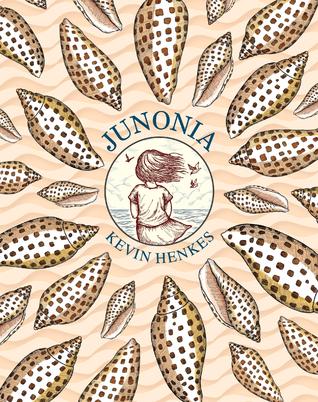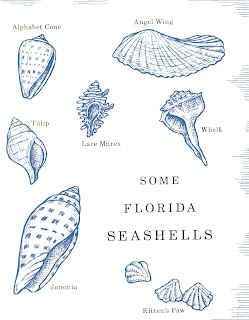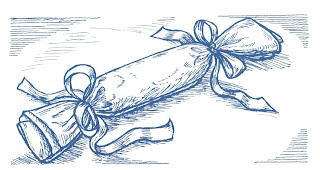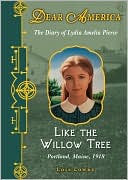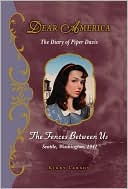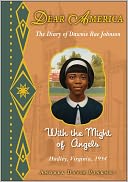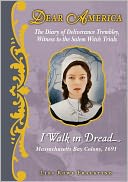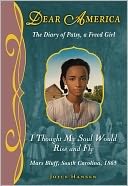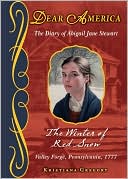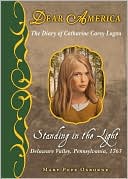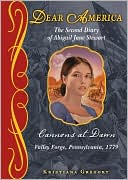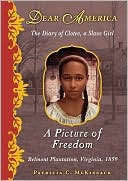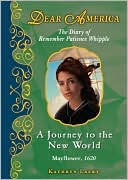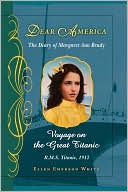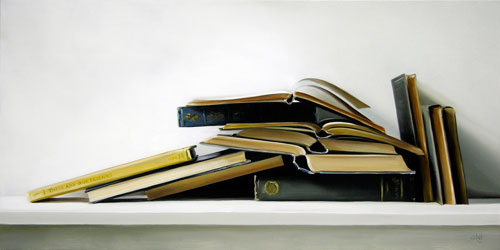I have no doubt that you all know the picture books of Kevin Henkes (pronounced Hen-kis), including his Caldecott winning Kitten's First Full Moon and the Caldecott Honor winning Owen, as well as the modern classics Chrysanthemum and Lily's Purple Plastic Purse, which came out in 1996 when my daughter was three. This book was a huge part of our lives (we have Lily and little brother Julius dolls as well as plastic purple purse that plays music) as was one of the best "new baby brother/sister" books out there, Julius, Baby of the World, which was very helpful when her little brother arrived a year later. We also had a fabulous interactive CD-Rom based on Henke's picture book, Sheila Rae the Brave, which got a lot of play in our house. Henkes' picture books have been such a huge part of my children's lives it amazes me that I have not mentioned his work once in the three years since I started this blog. A versatile illustrator and author, Henkes has also written a handful of chapter books, including the Newbery Honor winner Olive's Ocean and one of my favorites, Protecting Marie, about twelve year old Fanny, only child of older parents, and her yearning for a dog, something her artist father is opposed to. His newest book Junonia exhibits Henkes' characteristic ability to capture the pure emotional experiences of childhood (that are so easy to forget when you have grown up and are a parent) and translate them onto the page in words and pictures. Henkes is at his best when he is writing from the perspective of an only child, as he often does, and that is what we have with Alice Rice, the main character of Junonia.
Alice Rice and her mother and father have been visiting Sanibel Island in Florida for as long as she can remember. Every February when the weather is cold and dreary back home in Wisconsin, the Rices head to Florida for sun, sand and sea shells. And every year Alice's birthday falls during their vacation. As annual visitors, the Rices have become close friends with the other regulars. The Wishmeiers, a retired couple, and their grandchildren, the ancient Mr Barden, Helen Blair, an artist from New York City and special friend of Alice's and Mrs Rice's college friend Kate, sometimes known as Aunt Kate, make up a family of friends. Alice is especially looking forward to this vacation because she will be turning ten and everyone knows that double-digits are important. She hopes that, among the many special things that might happen on her tenth birthday, she finally finds a rare junonia shell while beach combing. However, as the marvelous Ann M Martin observes in her review of the book in New York Times, the very first paragraph of the book indicates coming changes. As the rental car crosses the bridge from the mainland to the island, Martin picks up on the symbolism, noting that "Alice, who normally enjoys being suspended between two worlds, suddenly feels strange. . . Henkes perfectly captures Alice's angst as she spins between the little-girlhood she's leaving behind and the adolescence that looms in front of her, and he expertly reveals introspective Alice's musings."
 Instead of happy things, small disappointments abound. Helen Blair is snowed in, the Wishmeier's grandchildren can't take time off of school to visit and Aunt Kate is bringing a new boyfriend, Ted, and his six year old daughter, Mallory. Alice is sad not to have her special friend Helen in Florida and frustrated that she has to share Aunt Kate's attentions with Ted and Mallory. Minor difficulties arise as do frustrations and, to many it may seem like the plot of Junonia is a bit uneventful. However, Henkes' gift is in paying attention to the small things that, over time, can shape how we view the world and behave in it. As an only child, Alice is more comfortable with quiet contemplation and less used to adapting to noisy distractions the way children from larger families often do. She is contemplative and watchful, noticing and making sense of the world around her as she goes. The drama in the story come from the ways in which Alice makes sense of and adjusts to the new people and situations that come in to her usually tranquil life. When Alice learns that she will have to share Kate, the doughnut she was eating "turned to dirt in Alice's mouth. The playful pattern of sunlight on the wall, which had elevated her mood just minutes earlier, now seemed frenzied, as if it were laughing at her misfortune." Even so, Alice is waiting in the driveway for Kate, Ted and Mallory to arrive.
Instead of happy things, small disappointments abound. Helen Blair is snowed in, the Wishmeier's grandchildren can't take time off of school to visit and Aunt Kate is bringing a new boyfriend, Ted, and his six year old daughter, Mallory. Alice is sad not to have her special friend Helen in Florida and frustrated that she has to share Aunt Kate's attentions with Ted and Mallory. Minor difficulties arise as do frustrations and, to many it may seem like the plot of Junonia is a bit uneventful. However, Henkes' gift is in paying attention to the small things that, over time, can shape how we view the world and behave in it. As an only child, Alice is more comfortable with quiet contemplation and less used to adapting to noisy distractions the way children from larger families often do. She is contemplative and watchful, noticing and making sense of the world around her as she goes. The drama in the story come from the ways in which Alice makes sense of and adjusts to the new people and situations that come in to her usually tranquil life. When Alice learns that she will have to share Kate, the doughnut she was eating "turned to dirt in Alice's mouth. The playful pattern of sunlight on the wall, which had elevated her mood just minutes earlier, now seemed frenzied, as if it were laughing at her misfortune." Even so, Alice is waiting in the driveway for Kate, Ted and Mallory to arrive.
 Mallory turns out to be a mercurial child coping with the absence of her mother, who has moved to France. The adults try to make things easier for Alice and Mallory to get along, organizing a shell hunt, but sustaining the peace proves impossible. Anything seems likely to set Mallory off, and Alice's birthday dinner is almost ruined by her. Alice struggles to accept Mallory, trying no to think the worst of her but finding it hard, especially after old Mr Barden calls her "the prettiest girl I ever saw," sending Alice, who thinks she is a plain girl with a strange birthmark on her face, into silence until she can cry in the privacy of her own cabin. The final straw comes when part of Alice's birthday gift from Helen Blair goes missing. Knowing that Alice is turning ten, Helen sends three boxes that contain items Helen collected for her on a recent trip to Italy - ten glass beads from Venice, ten gelato spoons in various colors and ten Euro coins. Alice is thrilled with the gifts and protective of them when she notices that Mallory is especially taken with the blue gelato spoon. After an outburst in which Mallory spills milk on Mr Barden, breaking up the party and leaving a mess in her wake, Alice is convinced that she has taken the blue spoon home with her. Initially unable to forgive Mallory, a calm day without her gradually changes Alice's mind and makes her wish she hadn't thrown Mallory's gift to her (a necklace made from a Kitten's Paw shell) into the waves. She has almost forgiven Mallory when she finds the missing spoon under a cupboard. When she recognizes what she has found, a "wonderful-horrible feeling crept up her neck. She was glad to have the spoon back, but regretful of all the terrible thoughts she'd had about Mallory. She turned red in the face and had the peculiar sensation that the whole world was watching." It is rare to read a children's book that explores their feelings, thoughts and responses to life so closely, identifying them and sorting them out. Whether adult or child, it is so easy to focus on intense emotions like happiness, sorrow and anger and move on without exploring the underlying feelings that they spring from. Junonia is not filled with big life lessons but rather the smaller, everyday occurrences that illicit emotions, shaping who we are depending on wether we pay attention to them or not.
Mallory turns out to be a mercurial child coping with the absence of her mother, who has moved to France. The adults try to make things easier for Alice and Mallory to get along, organizing a shell hunt, but sustaining the peace proves impossible. Anything seems likely to set Mallory off, and Alice's birthday dinner is almost ruined by her. Alice struggles to accept Mallory, trying no to think the worst of her but finding it hard, especially after old Mr Barden calls her "the prettiest girl I ever saw," sending Alice, who thinks she is a plain girl with a strange birthmark on her face, into silence until she can cry in the privacy of her own cabin. The final straw comes when part of Alice's birthday gift from Helen Blair goes missing. Knowing that Alice is turning ten, Helen sends three boxes that contain items Helen collected for her on a recent trip to Italy - ten glass beads from Venice, ten gelato spoons in various colors and ten Euro coins. Alice is thrilled with the gifts and protective of them when she notices that Mallory is especially taken with the blue gelato spoon. After an outburst in which Mallory spills milk on Mr Barden, breaking up the party and leaving a mess in her wake, Alice is convinced that she has taken the blue spoon home with her. Initially unable to forgive Mallory, a calm day without her gradually changes Alice's mind and makes her wish she hadn't thrown Mallory's gift to her (a necklace made from a Kitten's Paw shell) into the waves. She has almost forgiven Mallory when she finds the missing spoon under a cupboard. When she recognizes what she has found, a "wonderful-horrible feeling crept up her neck. She was glad to have the spoon back, but regretful of all the terrible thoughts she'd had about Mallory. She turned red in the face and had the peculiar sensation that the whole world was watching." It is rare to read a children's book that explores their feelings, thoughts and responses to life so closely, identifying them and sorting them out. Whether adult or child, it is so easy to focus on intense emotions like happiness, sorrow and anger and move on without exploring the underlying feelings that they spring from. Junonia is not filled with big life lessons but rather the smaller, everyday occurrences that illicit emotions, shaping who we are depending on wether we pay attention to them or not.
Although Alice turns ten in this book, I think it would be a perfect read for an eight year old, especially one who eschews fantasy. While it is easy to find real life girl stories that are bursting with vibrant characters (Beverly Cleary's Ramona Quimby, Sarah Pennypacker's Clemintine, Julie Bowe's Ida May) and exciting dramas (Secrets of the Cicada Summer, Strawberry Hill, Saffy's Angel, One Day and One Amazing Morning on Orange Street) there are few that are as focused on the thoughts and feelings of the main character and what goes on in her head as profoundly and purposefully as Henkes' Junonia. I almost put the book down about thirty pages into it because it felt like nothing was happening in the story. But, a day away from Alice made me realize that she was an interesting character who I wanted to know better, even if the worst thing that happened to her was having a six year old crash her annual vacation. The care and attention that Henkes' pays to creating this character, the fullness of her, is beautiful and a joy to experience.
The charming illustrations above are from the chapter headings in Junonia. I will leave you with an example of Henkes' wonderful writing and the lovely character he has created in Alice Rice,
The sun-bleached bedspread was printed with a pattern of a seaside Chinese village. Alice rand her finger over the rooftops and archways, over billowy swarms of butterflies and blossom-covered trees. Like a sailing ship, her finger traced over waves that reached up toward the clouds and swirls of mist. Here and there, the bedspread was threadbare, but Alice hoped it would never be replaced. She often fell asleep imagining that she was part of the village, wandering the twisting streets among the butterflies, collecting armfuls of blossoms.
 Instead of happy things, small disappointments abound. Helen Blair is snowed in, the Wishmeier's grandchildren can't take time off of school to visit and Aunt Kate is bringing a new boyfriend, Ted, and his six year old daughter, Mallory. Alice is sad not to have her special friend Helen in Florida and frustrated that she has to share Aunt Kate's attentions with Ted and Mallory. Minor difficulties arise as do frustrations and, to many it may seem like the plot of Junonia is a bit uneventful. However, Henkes' gift is in paying attention to the small things that, over time, can shape how we view the world and behave in it. As an only child, Alice is more comfortable with quiet contemplation and less used to adapting to noisy distractions the way children from larger families often do. She is contemplative and watchful, noticing and making sense of the world around her as she goes. The drama in the story come from the ways in which Alice makes sense of and adjusts to the new people and situations that come in to her usually tranquil life. When Alice learns that she will have to share Kate, the doughnut she was eating "turned to dirt in Alice's mouth. The playful pattern of sunlight on the wall, which had elevated her mood just minutes earlier, now seemed frenzied, as if it were laughing at her misfortune." Even so, Alice is waiting in the driveway for Kate, Ted and Mallory to arrive.
Instead of happy things, small disappointments abound. Helen Blair is snowed in, the Wishmeier's grandchildren can't take time off of school to visit and Aunt Kate is bringing a new boyfriend, Ted, and his six year old daughter, Mallory. Alice is sad not to have her special friend Helen in Florida and frustrated that she has to share Aunt Kate's attentions with Ted and Mallory. Minor difficulties arise as do frustrations and, to many it may seem like the plot of Junonia is a bit uneventful. However, Henkes' gift is in paying attention to the small things that, over time, can shape how we view the world and behave in it. As an only child, Alice is more comfortable with quiet contemplation and less used to adapting to noisy distractions the way children from larger families often do. She is contemplative and watchful, noticing and making sense of the world around her as she goes. The drama in the story come from the ways in which Alice makes sense of and adjusts to the new people and situations that come in to her usually tranquil life. When Alice learns that she will have to share Kate, the doughnut she was eating "turned to dirt in Alice's mouth. The playful pattern of sunlight on the wall, which had elevated her mood just minutes earlier, now seemed frenzied, as if it were laughing at her misfortune." Even so, Alice is waiting in the driveway for Kate, Ted and Mallory to arrive. Mallory turns out to be a mercurial child coping with the absence of her mother, who has moved to France. The adults try to make things easier for Alice and Mallory to get along, organizing a shell hunt, but sustaining the peace proves impossible. Anything seems likely to set Mallory off, and Alice's birthday dinner is almost ruined by her. Alice struggles to accept Mallory, trying no to think the worst of her but finding it hard, especially after old Mr Barden calls her "the prettiest girl I ever saw," sending Alice, who thinks she is a plain girl with a strange birthmark on her face, into silence until she can cry in the privacy of her own cabin. The final straw comes when part of Alice's birthday gift from Helen Blair goes missing. Knowing that Alice is turning ten, Helen sends three boxes that contain items Helen collected for her on a recent trip to Italy - ten glass beads from Venice, ten gelato spoons in various colors and ten Euro coins. Alice is thrilled with the gifts and protective of them when she notices that Mallory is especially taken with the blue gelato spoon. After an outburst in which Mallory spills milk on Mr Barden, breaking up the party and leaving a mess in her wake, Alice is convinced that she has taken the blue spoon home with her. Initially unable to forgive Mallory, a calm day without her gradually changes Alice's mind and makes her wish she hadn't thrown Mallory's gift to her (a necklace made from a Kitten's Paw shell) into the waves. She has almost forgiven Mallory when she finds the missing spoon under a cupboard. When she recognizes what she has found, a "wonderful-horrible feeling crept up her neck. She was glad to have the spoon back, but regretful of all the terrible thoughts she'd had about Mallory. She turned red in the face and had the peculiar sensation that the whole world was watching." It is rare to read a children's book that explores their feelings, thoughts and responses to life so closely, identifying them and sorting them out. Whether adult or child, it is so easy to focus on intense emotions like happiness, sorrow and anger and move on without exploring the underlying feelings that they spring from. Junonia is not filled with big life lessons but rather the smaller, everyday occurrences that illicit emotions, shaping who we are depending on wether we pay attention to them or not.
Mallory turns out to be a mercurial child coping with the absence of her mother, who has moved to France. The adults try to make things easier for Alice and Mallory to get along, organizing a shell hunt, but sustaining the peace proves impossible. Anything seems likely to set Mallory off, and Alice's birthday dinner is almost ruined by her. Alice struggles to accept Mallory, trying no to think the worst of her but finding it hard, especially after old Mr Barden calls her "the prettiest girl I ever saw," sending Alice, who thinks she is a plain girl with a strange birthmark on her face, into silence until she can cry in the privacy of her own cabin. The final straw comes when part of Alice's birthday gift from Helen Blair goes missing. Knowing that Alice is turning ten, Helen sends three boxes that contain items Helen collected for her on a recent trip to Italy - ten glass beads from Venice, ten gelato spoons in various colors and ten Euro coins. Alice is thrilled with the gifts and protective of them when she notices that Mallory is especially taken with the blue gelato spoon. After an outburst in which Mallory spills milk on Mr Barden, breaking up the party and leaving a mess in her wake, Alice is convinced that she has taken the blue spoon home with her. Initially unable to forgive Mallory, a calm day without her gradually changes Alice's mind and makes her wish she hadn't thrown Mallory's gift to her (a necklace made from a Kitten's Paw shell) into the waves. She has almost forgiven Mallory when she finds the missing spoon under a cupboard. When she recognizes what she has found, a "wonderful-horrible feeling crept up her neck. She was glad to have the spoon back, but regretful of all the terrible thoughts she'd had about Mallory. She turned red in the face and had the peculiar sensation that the whole world was watching." It is rare to read a children's book that explores their feelings, thoughts and responses to life so closely, identifying them and sorting them out. Whether adult or child, it is so easy to focus on intense emotions like happiness, sorrow and anger and move on without exploring the underlying feelings that they spring from. Junonia is not filled with big life lessons but rather the smaller, everyday occurrences that illicit emotions, shaping who we are depending on wether we pay attention to them or not.Although Alice turns ten in this book, I think it would be a perfect read for an eight year old, especially one who eschews fantasy. While it is easy to find real life girl stories that are bursting with vibrant characters (Beverly Cleary's Ramona Quimby, Sarah Pennypacker's Clemintine, Julie Bowe's Ida May) and exciting dramas (Secrets of the Cicada Summer, Strawberry Hill, Saffy's Angel, One Day and One Amazing Morning on Orange Street) there are few that are as focused on the thoughts and feelings of the main character and what goes on in her head as profoundly and purposefully as Henkes' Junonia. I almost put the book down about thirty pages into it because it felt like nothing was happening in the story. But, a day away from Alice made me realize that she was an interesting character who I wanted to know better, even if the worst thing that happened to her was having a six year old crash her annual vacation. The care and attention that Henkes' pays to creating this character, the fullness of her, is beautiful and a joy to experience.
The charming illustrations above are from the chapter headings in Junonia. I will leave you with an example of Henkes' wonderful writing and the lovely character he has created in Alice Rice,
The sun-bleached bedspread was printed with a pattern of a seaside Chinese village. Alice rand her finger over the rooftops and archways, over billowy swarms of butterflies and blossom-covered trees. Like a sailing ship, her finger traced over waves that reached up toward the clouds and swirls of mist. Here and there, the bedspread was threadbare, but Alice hoped it would never be replaced. She often fell asleep imagining that she was part of the village, wandering the twisting streets among the butterflies, collecting armfuls of blossoms.
Readers who liked this book might also enjoy:
The Book of Coupons and Secret Letters from 0 to 10 by Susie Morgenstern
